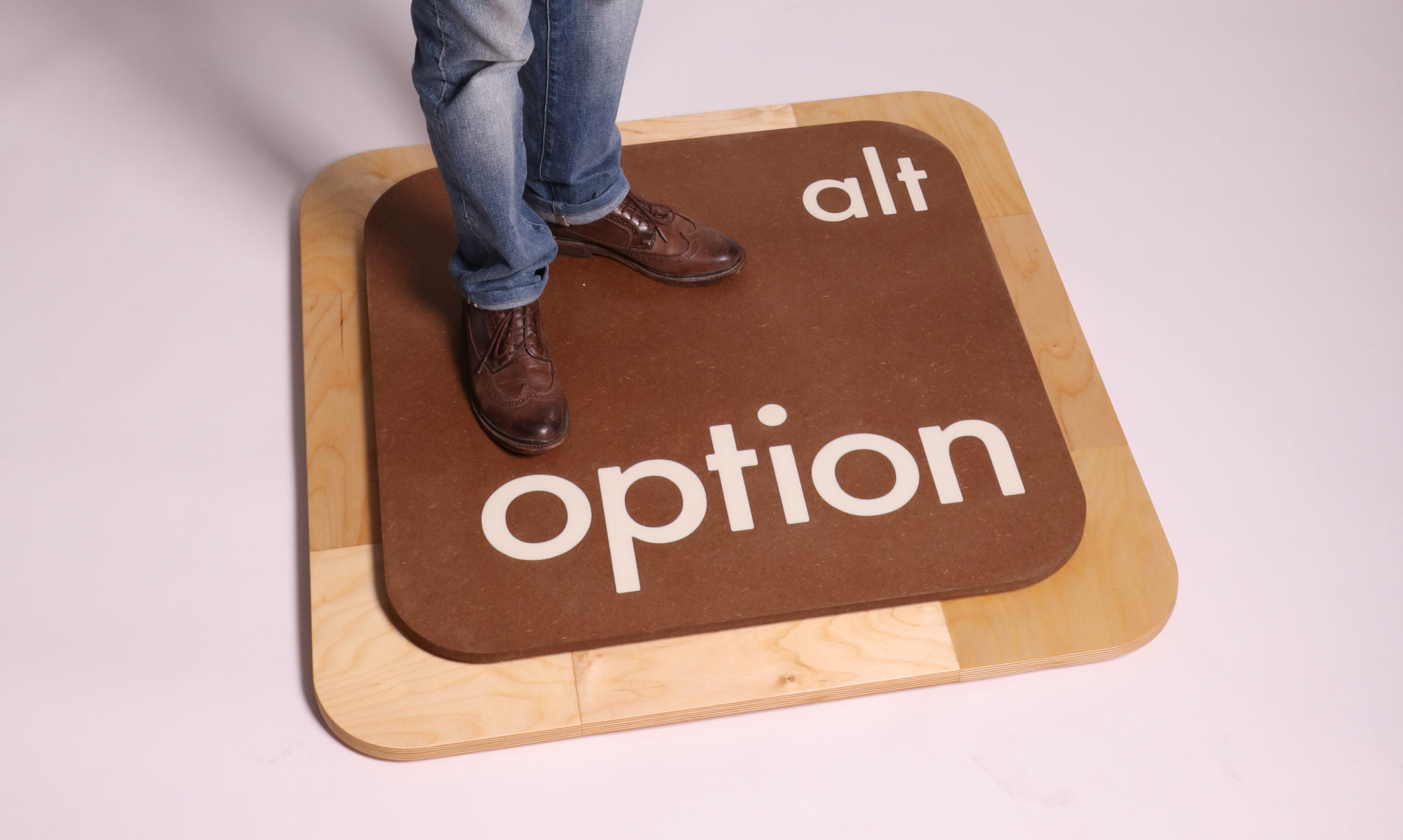Here is some brainstorming and research I did for the National Park game that I didn’t even end up making. I still might want to do this someday though, just not right now..
Case Study – Mindful Memorial Services
Short Summary
As rival funeral directors, compete to have the highest total score by appeasing deceased and loved ones’ wishes, while also trying to reduce negative environmental impact.
This game is heavily based on the idea of green final disposition (a concept explained at the beginning of rule book). This game is both meant to get people to emphasize with people and think about how loved ones may have different wishes than the actually deceased and to also educate people about some of the harmful effects of “mainstream” final dispositional methods while also teaching about some more green alternatives!
Primary Audience: 13+ at minimum because it has some darker themes, particularly people interested in funeral services like people studying to become morticians, alternative people, etc.
Design Process & Thought Process
Iterative Design:
For the initial design, I made different tile designs based on the different disposition methods. This was made using Adobe Stock Imagery, to get a baseline down for a prototype. In future iterations, I will draw this imagery by hand, but still keep a more simplistic, cartoony art style.
The token designs are simple icons that represent the different things like energy, emotion, CO2, etc. I drew these vector icons myself in Adobe Illustrator (not that impressive, but you know).
The card design was also entirely drawn by me, with the people being in a very cartoony, simplistic style, that is honestly purposefully bad-looking. I tried to switch up the people’s hair and skin colors to vary it a little bit, but in future designs, I want to give them more variety and character. I may also consider giving some of them religious garments that players will want to factor into their decisions they make. For the Deceased cards specifically, I just took the Loved Ones cards and put a blue tint over it so they looked more “ghostly”. In future versions, I’ll also want to give these more variety and might make them a little more “ghost-like”, without getting too far away from being human.
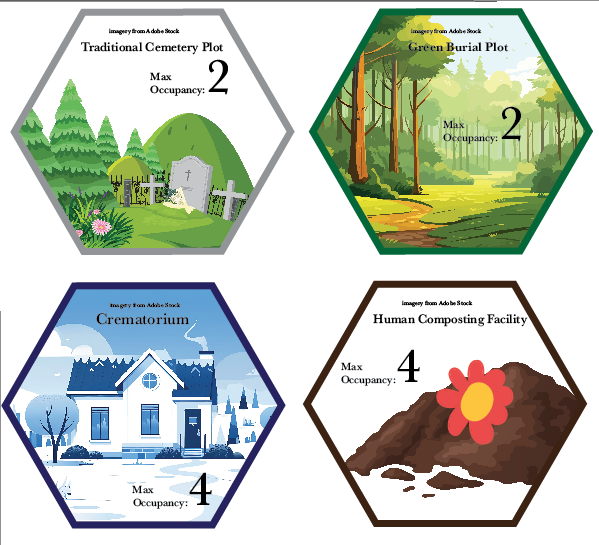
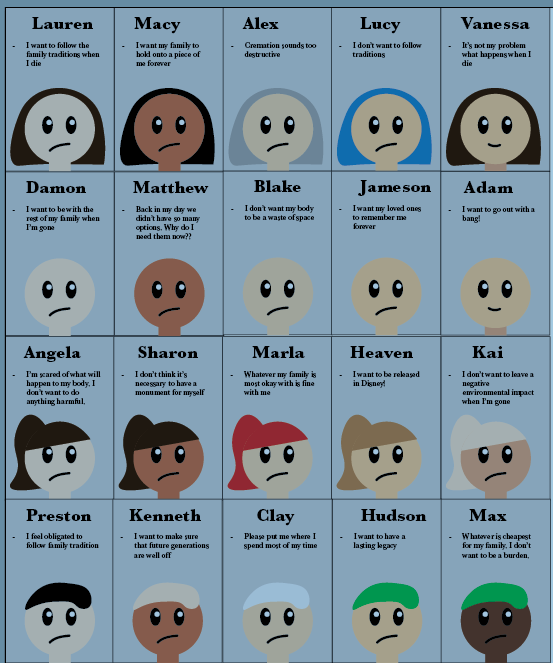
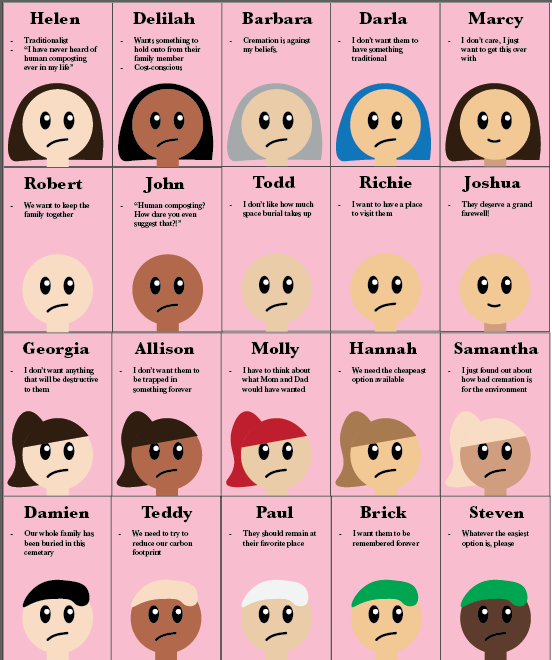
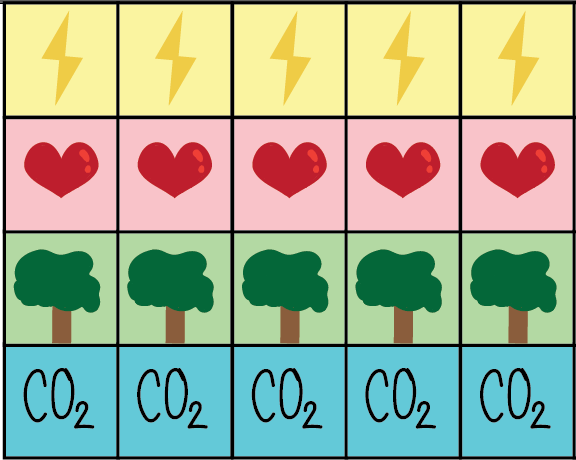
Game Mechanics:
You draw both a “Deceased” and a “Loved One” card each turn. You must look at what their wishes are and try to make a judgement about what disposition method they would be the happiest with. This can be a difficult decision, because the deceased and the loved ones can have conflicting opinions.
To select a disposition method, you trade in the required number of resources to place the deceased on that tile and lay them down. You can only do this if the tile hasn’t reached it’s max capacity, so you may also need to use your resources to purchase a tile if none are available. Different methods cost different resources and different amounts of them, so that is another thing that factors into the decision to use a method. You then reveal what methods the loved ones and the deceased were okay with and award yourself emotion tokens based on this.
With there being max capacities to tiles, it makes the game exciting for multiple players since you can use up the tiles and force someone else to purchase a tile on their turn.

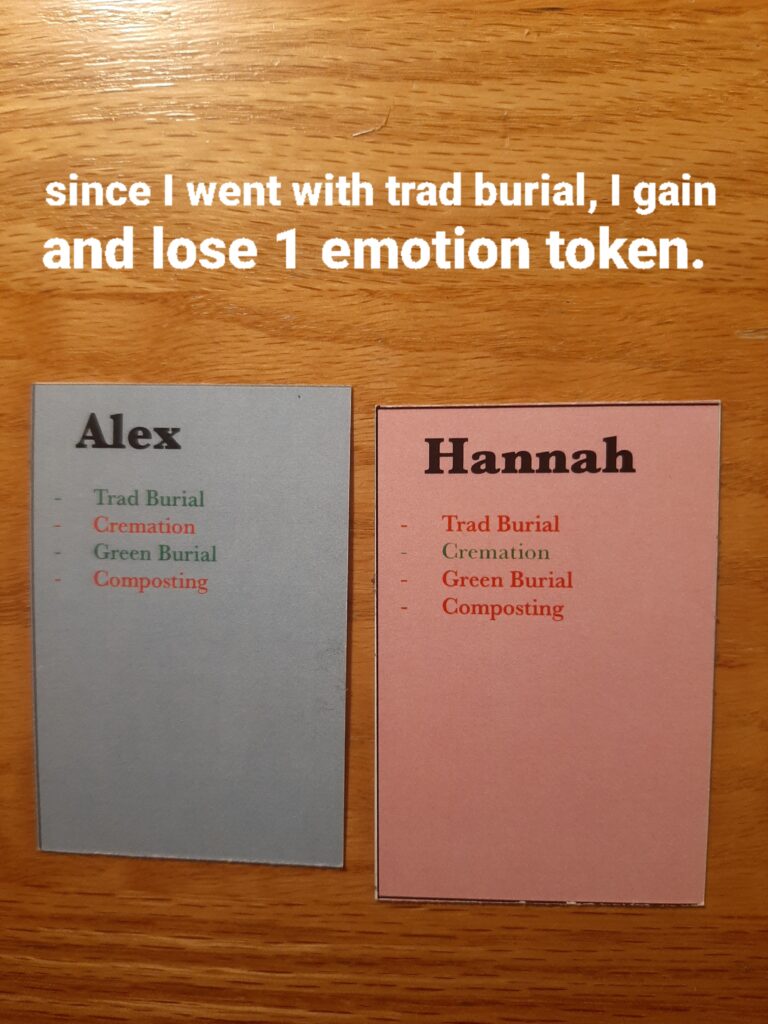
Player Goals:
To try to appease both the “Deceased” and “Loved Ones”, while trying to still run an environmentally-friendly funeral services business. Ultimately, you want to have the most trees, energy, and emotion tokens, but have as little as possible of the CO2 tokens. Based on this, the player with the highest score wins.
Gameplay Sequence:
On Your Turn
- Draw one “Deceased” and one “Loved Ones” card
These are the “clients” for your turn. You must consider both of their personalities and wishes when making a decision for how to lay the Deceased to rest. DO NOT look at the back of either of the cards.
- (Optionally) Purchase and Place a Tile
Using your resources, you may purchase and place a tile during your turn. SEE TILES SECTION FOR MORE DETAILS.
- Cemetery tile
- Crematorium tile
- Green burial tile
- Human composting facility tile
- Decide on which Method of Final Disposition to Use
Once you have decided, place the card of the Deceased on the tile according to the method you wish to use. SEE TILES SECTION FOR MORE DETAILS.
- IF you cannot lay your client to rest during your turn, you will lose 2 emotion tokens
- Collect and Discard Corresponding Resources
- Flip both the Deceased and Loved One card over to see the effects of your decision. If you selected a final disposition method that is in red, lose one emotion token. If you selected a final disposition method that is in green, collect one emotion token.
- According to the method of final disposition, collect and discard the resources that correspond to that method. (See the Tiles section for more information)
The gameplay ends based on the number of players. For 2 players, play until everyone places 7 Deceased Individuals. For 3-4 players, play until everyone places 5 Deceased Individuals.
Game Board & Components:
As of right now, there isn’t one centralized game board, but instead, you start the game with one cemetery and one crematorium tile and the game “board” is built throughout the game, as players purchase more tiles using their resources. In the future, I think a board that tiles fit nicely into would be a nice addition. This could also have the first cemetery and crematorium tile built into it for easy set-up. A centralized game board will also help guide players through the game more easily, with there maybe helpful reminders on the side about the resource cost of tiles.
I also have a few stipulations to building the game board, like with the cemetery tiles, you have to always place them against each other. I think it would be interesting to add more rules like this to the game board building process.
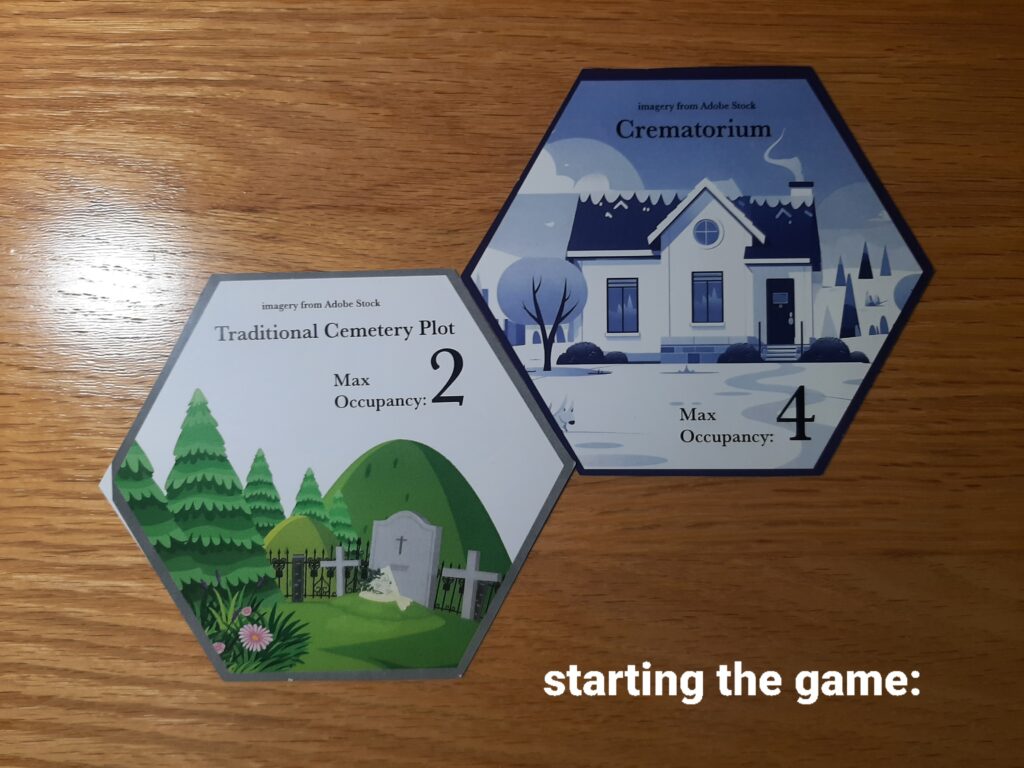

Rulebook and Playtesting
Rulebook Sample:
Playtesting Notes:
Overall, from playtesting I learned of certain things I can do to help players be guided through the game more easily. In the future, I should have reference cards or something on a centralized game board that quickly overviews the effects of using the different disposition methods. I should also include somewhere, like on the tiles themselves for instance, how much they cost so that players don’t have to constantly refer to the rules.
I also need to revisit the cost and benefits of the more “green” alternatives, because I don’t think anyone ended up using the human composting facilities. See below for more notes.
- What questions did your players have? There weren’t a lot of questions, but they would ask each other about the requirements and what would happen with each tile.
- How quickly did they learn to play? They learned to play pretty quickly. The only thing that was a little difficult to get used to were the specific requirements and actions that happened with each tile, so a key would probably be helpful.
- What kinds of interactions did the players have? Players would influence the next player’s turns by taking up the different tiles. Players could max out the tiles, making the next person have to purchase a brand new tile. Players also would discuss about the people and their wants and needs
- What confused players? I feel like the players didn’t really have that much confusion.
- What made players excited? I think players were excited when they satisfied both the deceased and the loved ones.
- What did your players enjoy doing? I think they enjoyed looking at the different character cards and how their needs and wants differed.
- Did any aspect of the game frustrate players? I think having to refer to the rules constantly frustrated players, also not being able to obtain more energy very easily so it made them not want to do cremation or human composting.
Other playtest notes
- clarify the way tiles are placed
- i think the human composting needs more benefits
- a way to yet more tokens
- get more energy
- maybe something to mark that the tiles aren’t open when they are maxed out
- a key
- Maybe add how they died, with effects from that
- extra card and it could effect if they get buried or cremated
- maybe green burial plots need to be separation
- maybe the green ones can’t be near a crematorium
- pretty easy to learn but there were a few things that they had to keep referring to
Game Reflections:
To reflect on this game, I honestly feel like I have a pretty solid start to make this a decent game. Playtesting was great to see that players actually enjoyed making the decisions about how the bodies should be “put to rest”, and I like how it also became something that was almost storytelling (like how are the deceased connected to the loved ones?).
Still, there are definitely some things I would do differently next time and with future versions. First, I want to fix all of the comments that I made based on my playtest notes. Specifically, I want to work out the resource values of the cards, and really refine the balance of that. I also need to find a way for players to get more energy tokens in the game.
I also think it would be interesting to add some more information about the different disposition methods, just for the sake of the player’s education. A few of my players didn’t know about the other alternatives such as human composting, and I think that would really add to the purpose of my game. In addition to that, I would also potentially like to add more disposition options, and maybe even some of the more ridiculous ones like being sent to space or turned into a diamond.
The game tile pieces would also need some refining, in both the design and in the feel. I like the idea of using magnetic tiles so that they don’t shift around, or maybe 3d printed or nicely cut woodblock tiles. I toyed around with the idea of velcro, but on second thought, I’m really not sure about that.
I really hope I get to revisit this game someday!
Dome Projection Trials – Maria
For my project, I chose to project various footage of cells and organisms observed through the lens of a microscope. The goal of this experiment was to be immersive, and test how some of life’s smallest structures could be displayed on a large scale.
First, I took all of my images and placed them over a black background via Instagram stories. This allowed me to quickly, and easily, crop the top layer image (through the microscope) into a perfect circle. I saved my creations back to my camera roll. Since I could not follow this same process for other forms of media, I used Adobe Premiere Pro to create a circular black mask around my video content. I then uploaded all of the media into iMovie so that I could arrange my content, add transitions, and adjust play speed. Since iMovie formatted everything onto a black rectangle, I utilized Adobe After Effects to crop my final into a square the size of my circular content and export as seen above. This would allow the footage to be compatible with RMU’s dome projector.
Projection Sammy Homer
For my experiment I decided to do a projection of a car ride to RMU specifically when it rains for more immersion in the dome. I also wanted experimented with direction by turning the camera. I used my phone camera because I already had a specific spot for it and thought a circle around it would fit it on the dome. I didn’t realize my video was still not the right size until trying it out and it also made me realize that I need to consider length as the load time was very long.
I did another experiment that could have been a transitioned from the last experiment as it was me walking around RMU specifically going from Business School to the Gazebo. I realized only after that I recorded way too much and had to trim it done and speed it up. I also noticed that the camera was very unsteady compared to the other one (probably because I was holding it in this one) and the circle I tried to create turned to a weird oval that warp the image somewhat at the center.
Light Study-Emma Ribblett
Space and light
In the dome
Photos
Projection
Chore Champs game
Shadow art video
The Perfect Human
Obstructions
- Must have a bottle of coke.
2) No dialogue
3) Only one person at a time in the shots
4) Have long shots/not a lot of cuts
5) Person must have word written on forehead
Obstructions Rules 3 minute video : The Perfect Wife
Rules:
- No effects, must be in one theme
- Not fast, but more calm and slow
- Film outside
- Have people talk their thoughts out loud
- Beautiful Nature scene
Projections Drawing Video
Week 12
I unfortunately did not get to work on this much more over this past week because I got sick. I did however come up with a few more ideas. Adding cards to slow down or speed up other players.
Week 11
So the last game ended up way better than the first, the only problem I ran into was the material of the cards. The cards got ruined very easily and had to be replaced within a week or two. Other than that, I am trying to work on another drinking game. I know its not original for me but the reason I enjoy making drinking games is because thats what me and my friends and family enjoy playing when we are all together. So far the idea is gonna be a bank heist theme. Still working out the details so no physical copy is made yet. The concept is that the player draws cards and works towards a goal. (Not Sure What That is Yet) You win the game by getting into the vault. The vault is a drink of choice from each player playing. So think of it more like gambling. Its a board game but you essentially wager with a can of White Claw for example. I think its a cool concept, just need to figure out the smaller things.
